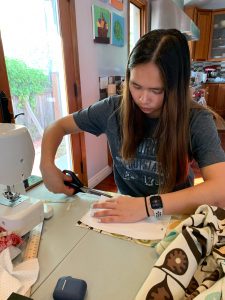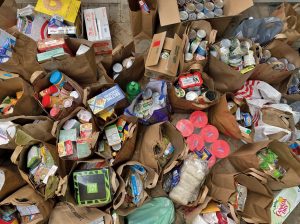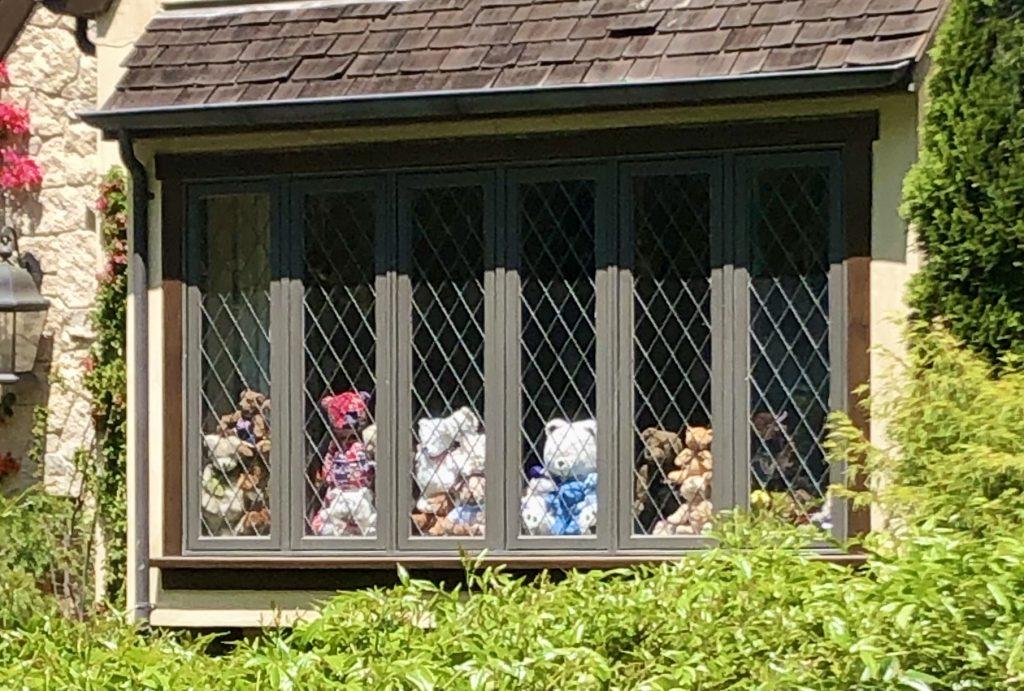Even during a pandemic, Palo Alto residents are finding ways to reach out to one another. They are making masks, decorating their streets with art and games and organizing food drives for those in need. They are finding ways to spread positivity and stay connected, albeit from a distance.
Mask from scratch: Masks of Hope sews and snips
The advice of “Masks Strongly Advised” stunned local Americans in shelter-in-place. This new accessory was foreign to them, only for those in hospitals and construction. In Asia, however, masks have been a staple precautionary item to slow the spread of disease for decades. For example, pre-pandemic, it was common to see ordinary citizens on the streets of Taipei wearing surgical masks when they weren’t feeling well. Similarly, the Taiwanese American and Chinese community of Palo Alto recognized and understood the importance of masks, thus, sparking the creation of a new organization, Mask of Hope. Mask of Hope aims to hand make and distribute face masks to people of need in the Bay Area.
“It is my belief that the cloth masks that Masks of Hope are making are extremely helpful in these times when we need protection from a virus.”
— Julian Hong, Greene Middle School student
Story continues below advertisement
“Our group started with a few parents and students from Greene Middle School and now has grown to almost 30 contributors,” Olivia Chen, a Greene Middle School parent and one of the original members of Mask of Hope, said.
The trying times of quarantine and Chen’s social media advertising on social media grew the Mask of Hope’s membership and made it into a community effort that anybody could participate in.
“We have people donating money to cover materials that are becoming hard to procure like thread, fabric and elastic,” Chen said. “Some are helping to cut fabric because they can’t sew.”
The distribution of materials is completely contactless. Bags filled with sewing materials and fabric are dropped off at doorsteps, and masks for donation are picked up at houses.
The distribution of materials is completely contactless. Bags filled with sewing materials and fabric are dropped off at doorsteps, and masks for donation are picked up at houses.

The involvement of middle school and high school students has been an important part of the Mask of Hope program. It is a bonding experience with the students and their parents and a way to give back to their communities from the safety of their own homes, while giving them the opportunity to learn or improve their sewing.
“It is my belief that the cloth masks that Masks of Hope are making are extremely helpful in these times when we need protection from a virus,” Julian Hong, Chen’s son and student at Greene Middle School, said. “The mask making also serves as a welcome distraction from the quarantine.”
As of April 24, Mask of Hope has donated 722 cloth masks and 2885 single-use masks to groups in need. These groups include the elderly, local stores in Palo Alto and essential workers. The whole organization made by just a few parents and children has created so much good in the community with just fabric and thread.
“The most rewarding part is recognizing the fabrics that I cut and seeing that they are going to help someone,” Palo Alto High School freshman Alexis Chiu said.
Grassroots giving: Artwork and games and bears, oh my!
Even as daunting phrases like “social distancing” and “shelter-in-place” appear again and again in news outlets and on social media, Palo Alto residents still find ways to spread positivity. Setting up teddy bear hunts and creating small works of art around their houses are just two of the many ways that families are spreading hope in the community during this unprecedented, isolating time.
Inspired by Michael Rosen’s book “We’re Going on a Bear Hunt,” teddy bears have popped up in windows all around the world as communities look for ways to entertain and divert young children. Kids can go outdoors and test their scavenger hunting skills in the form of this family friendly, socially distanced game.

“It gave a fun purpose to our walks,” Palo Alto resident Angela Harris said. “We kept count on how many we spotted and it was good to see new ones on our walks through the neighborhood.”
When Addison Elementary School mom Lisa Bertelsen goes out with her kids for walks around the block, she frequently sees bears from the teddy hunt.
“It makes us feel less isolated,” Bertelsen said. “Every once in a while I remind them [her kids] that the grownups who live in these houses are bringing out their stuffies as a way of showing children that they understand how hard it is to stay home and that they care. So it creates a shared sense of purpose and solidarity.”
Another way that Addison students are creating community during this time is by reviving a tradition that usually occurs around Halloween. Students “Boo” their friends, by leaving a surprise gift, such as a treat or a drawing, on their doorsteps.
“Kids like to find things, so it’s almost a game to try and spot the painted rocks. [We] hope that our neighbors feel happier.”
— Anisha and Divya Gandhi, Palo Alto residents
“A few kids have started doing quarantine Boos. Just a little gesture that shows the kids that their friends are thinking of them,” Bertelsen said.
Palo Alto mom Charu Gupta is also participating in the community fun, even though she doesn’t have teddy bears. After finding out about the hunt from a friend’s Facebook post, she immediately pulled out some bunny toys and placed them in easily visible windows.
“It seemed like a fun thing to do to just put a smile on our neighbors’ faces,” Gupta said.
Gupta has also seen a variety of other activities on her walks around the neighborhood including a chalk maze, hopscotch and even a fellow resident playing his saxophone from his garage. Her daughters, Anisha and Divya Gandhi, have made their own contribution to the community’s positive atmosphere by painting stones and placing them outside their house.
People passing by regularly stop to point out the colorful rocks to their children. The Gandhis were even asked to paint personalized rocks for a neighbor who admired their work.
“Kids like to find things, so it’s almost a game to try and spot the painted rocks,” Anisha and Divya wrote in a shared email. “[We] hope that our neighbors feel happier.”
Service organizations: Community groups continue to help
It is all too easy to stay secluded and isolated, but there are endless opportunities to get involved with the community through these difficult times. For those that have the means, supporting big organizations that help others is one of the best ways to aid people in the coronavirus pandemic.
Due to the current crisis, service organizations are more important than ever. Although the virus has impacted everyone across the world, it affects certain demographics disproportionately including doctors, essential workers, undocumented immigrants and those who have been laid off from their jobs. Service organizations such as the Ecumenical Hunger Program and the Boys & Girls Clubs of the Peninsula have been putting in their all to help these communities in any way they can.
“We’re doing our best to keep people knowing that we care, that we’re here to support them. A smile does wonders for people when they’re discouraged.”
— Lesia Preston, EHP Executive Director
EHP’s mission is to provide assistance to families and individuals experiencing economic and personal hardship. During the pandemic specifically, EHP has done this by giving food and other essentials to those in need; to maintain social distancing, the organization has been mostly serving people from their cars, with vehicles entering through one gate and exiting out the other. EHP Executive Director Lisa Preston explained that this help extends beyond economic support, as people are struggling with feelings of anxiety, confusion and distress.
“We’re doing our best to keep people knowing that we care, that we’re here to support them,” Preston said. “A smile does wonders for people when they’re discouraged. Having someone to give service with a smile is always a blessing.”
Palo Alto High School students have been finding ways to get involved with EHP. Three members of the Social Justice pathway, including Paly junior Catherine Reller, helped organize a food drive for EHP.

“We get kind of stuck in like a bubble of Palo Alto,” Reller said. “I can’t speak for everyone but it hasn’t really affected our community as much, but in communities that are really close to ours people are being affected by it greatly and I think it’s important to help out and give back.”
Another service organization that is at work is the BGCP, an organization whose goal is to provide low-income youth with the resources and opportunities they need to succeed. In such a critical time for this community, BGCP Chief Executive Director Peter Fortenbaugh said that the organization has been taking action by serving and distributing food and supporting students and their academic relationships with teachers and peers.
“It’s a great position to be in that we’re able to help others and be whole throughout this process,” BGCP Chief Executive Director Peter Fortenbaugh said. “We have tremendous appreciation for all the volunteers who have stepped up to partner with us.”
Like EHP, BGCP has been allowing limited numbers of volunteers to help out, including Paly students who are regular volunteers or have pitched in recently. Kimi Lillios, a Paly junior, began working with BGCP soon after the coronavirus started affecting communities.
“Now, it’s more important than ever, that we stay united as a community,” Lillios said. “It’s really easy to stay secluded and stay focused on yourself, but there are a lot of ways you can get involved with the community and help each other out through these difficult times.”
To help out the less fortunate during this time, the best course of action would be to donate, according to Preston. Volunteering — although it’s helpful — is limited due to social distancing guidelines, and donating is something that everyone can do from their homes.
“We can’t do this work without others supporting us, and we’re very grateful for those that give their donations and their time to help make EHP successful,” Preston said. “All I can say is thank you.”
Links to local service organizations:
Ecumenical Hunger Program: https://www.ehpcares.org/donate.html
Boys & Girls Club: https://www.bgca.org/ways-to-give
Community Services Agency: https://www.csacares.org/donate/
La Comida: https://www.lacomida.org/get-involved/
Jewish Family and Children’s Services: https://www.jfcs.org/give/
LifeMoves: https://www.lifemoves.org/covid-19-update/
Silicon Valley Community Foundation: https://www.siliconvalleycf.org/coronavirus-response
Ronald McDonald House: https://rmhcbayarea.org/give
Second Harvest of Silicon Valley: https://www.shfb.org/give-help/
Related Stories
Reading toward the future: Senior citizens read to young students
A homemade meal: Building community one meal at a time
Friendly neighborhood food truck: Lee’s catering serves local construction workers





